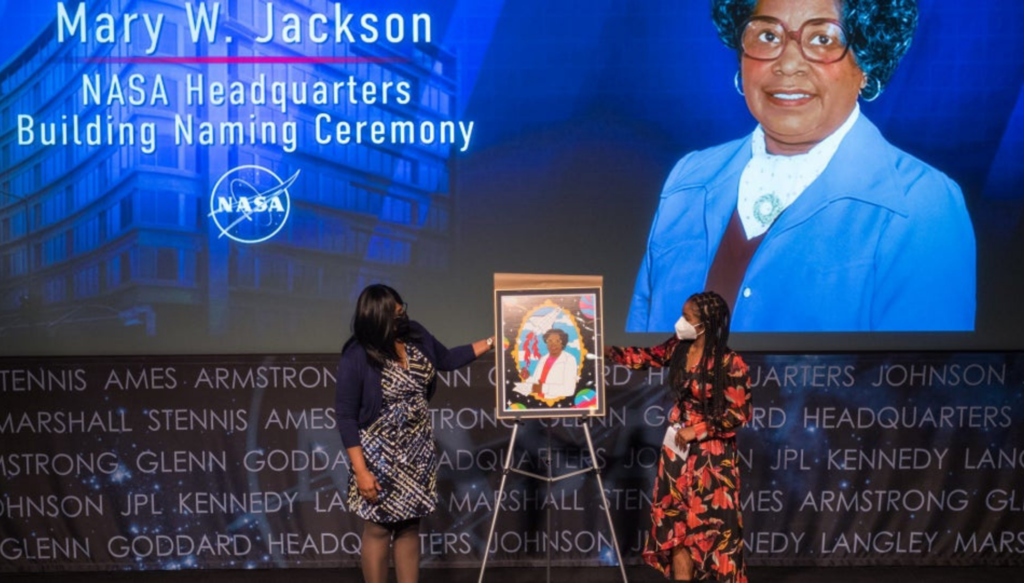Her name is emblazoned in history!
NASA has renamed its Washington, DC headquarters after Mary W. Jackson, its first Black woman engineer. Jackson received this honor, posthumously, for advocating for equity and breaking barriers in a discipline that white men have historically dominated. The icon served as the inspiration for the book turned film, “Hidden Figures,” her role being played by Janelle Monáe.
NASA held a ceremony Friday to officially rename its Washington, D.C. building in honor of Mary Jackson, the space agency’s first Black woman engineer. pic.twitter.com/F7PEX97Jci
— TODAY (@TODAYshow) February 27, 2021
“With the official naming of the Mary W. Jackson NASA Headquarters, we ensure that she is a ‘hidden figure’ no longer,” acting NASA Administrator Steve Jurczyk said in a statement. “Jackson’s story is one of incredible determination. She personified NASA’s spirit of persevering against all odds, providing inspiration and advancing science and exploration.”
She helped us propel the dawn of the Space Age through her work as a ‘human computer’. Now, our headquarters building will be named in her honor. Get to know Mary W. Jackson, our first African American female engineer: https://t.co/QvrTKd3L2Z pic.twitter.com/pJd6h8AttM
advertisement— NASA (@NASA) February 26, 2021
She graduated from Hampton Institute, now Hampton University, in 1942, where she received a Bachelor’s of Science degree in mathematics and physical science. She worked at the National Advisory Committee for Aeronautics, the precursor to NASA, in April 1951, where she was dubbed the “human computer” within the segregated West Area Computing Unit, now NASA’s Langley Research Center in Hampton, VA.
After doing great work in the computing pool, Jackson was asked to work in the 4-by-4-foot Supersonic Pressure Tunnel. This wind tunnel had 60,000-horsepower and was capable of reaching speeds that were twice the speed of sound. She received hands-on training conducting experiments and her supervisor suggested she enter a training program which would allow her to rise from mathematician to engineer. Jackson then sought special permission to attend the then segregated Hampton High School and in 1958 became NASA’s first Black woman engineer.
She joined Langley’s Federal Women’s Program in 1979 and fought for the hiring and promotion of women as mathematicians, engineers, and scientists. The STEM pioneer also worked with youth, helping the King Street Community Center build a wind tunnel to use in their own experiments.
“We have to do something like this to get them interested in science,” she reportedly told a local newspaper. “Sometimes they are not aware of the number of Black scientists, and don’t even know of the career opportunities until it is too late.”
Jackson retired from Langley in 1985 and passed away in 2005 at 85-years-old. She was posthumously awarded a Congressional Gold Medal in 2019 along with her fellow engineers and mathematicians, Katherine Johnson, Dorothy Vaughan, and Christine Darden.
The celebration at NASA occurred Friday, February 26, with video tributes reflecting on Jackson’s career and legacy from her loved ones, NASA employees, astronauts, and other esteemed guests. Famous poet Nikki Giovanni read an excerpt of her poem, “Quilting the Black-Eyed Pea,” which explores the intersection of space and civil rights. NASA officials said that Jackson’s commitment to excellence, diversity, inclusion, and teamwork represented the best of the current employees and the future of the agency.
In a statement, the agency wrote, “embracing an inclusive culture is central to all NASA does and is reflected in the recent addition of inclusion as one of the agency’s core values, along with safety, integrity, teamwork, and excellence.”
Langley Director, Clayton Turner, added that Mary Jackson remains an inspiration to the agency.
“Her perseverance, her empathy, her desire to lift us all—she inspired others to excel and to break through barriers,” Turner wrote. “That is the spirit of NASA. Mary Jackson chose to lead by example, and at NASA today, we strive to emulate her vision, passion, and commitment.”
Her fans on social media were enthusiastically waiting for the unveiling.
Excited about this today! NASA headquarters being renamed to honor Mary Jackson! https://t.co/DaqeKzGFE1
— Ranthony A.C. Edmonds, PhD (@RanthonyEdmonds) February 26, 2021
advertisement
NASA is naming their headquarters after hidden figure, Mary Jackson…
She was the first black woman engineer at the agency…a queen ✨ pic.twitter.com/xtGrRILyuM
advertisement— Baby Stallion (@AbsntMndGenius) February 25, 2021
For her school’s History Day celebration, 8-year-old Naomi dressed up as NASA trailblazer Mary Jackson. Once a Hidden Figure, Jackson was NASA’s 1st African American female engineer.
advertisementToday, @NASA‘s HQ building is being renamed in Mary Jackson’s honor.https://t.co/yvXy1Op1Yu pic.twitter.com/dLyBun5T2f
— NASA STEM – Inspiring the #Artemis Generation (@NASASTEM) February 26, 2021
She paved the way for Black astronauts such as Janet Epps and Victor Glover have recently made history with their selection for historic missions into space.
Photo Credit: NASA

